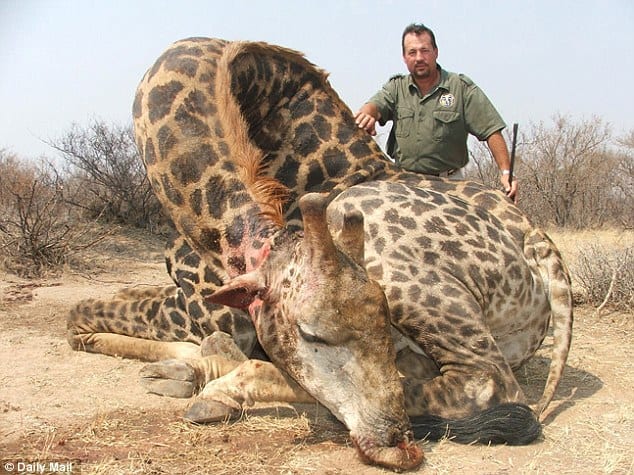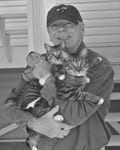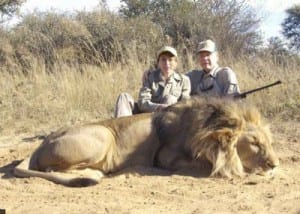Letters: The hunting mania and other degeneracies

Giraffe murdered, with undisturbed murderer at the site of his crime. This image sums up the abject degeneracy of our civilization and the utter uselessness and corruption of the leaders who run our societies, to say nothing of the bankrupt media that does nothing to counteract these outrages. It is an indictment of a whole global system, and the pervasive, mostly unchallenged selfishness of our species.
By Paul Craig Roberts Hribal’s “Fear of the Animal Planet” Jason Hribal in a book just off the CounterPunch/AK press, Fear of the Animal Planet: The Hidden History of Animal Resistance, regales the reader with tales of animal rebellion and escape from captivity. In Hribal’s account, when big cats, elephants, and orcas injure or kill their trainers and keepers they are inflicting retribution for the abuse and exploitation that they suffer. [pullquote] As is inevitable for all people who are both decent and intelligent, Dr Roberts is also an animal liberationist. He sees clearly through the abject, groundless prejudices that privilege humans at the expense of animals. Indeed, the battle against speciesism, the oldest and most brutal form of mass tyranny on record, will constitute the last revolution in the advance of human beings toward virtue. [/pullquote] One of Hribal’s most convincing examples is Tatiana, a Siberian tiger in the San Francisco zoo. On December 25, 2007, Tatiana cleared the 12 foot high wall of her enclosure to decimate the teenagers who enjoyed themselves tormenting her. Tatiana ripped one of her tormenters to pieces, and, during her 20 minutes of freedom, she searched the zoo grounds for the other two, ignoring zoo visitors, park employees, and emergency responders. As Hribal puts it, “Tatiana was singular in her purpose.” She could have killed any number of people, but ignored them in pursuit of her tormentors. Obviously, Tatiana could have escaped from her enclosure whenever she had wished, but had accepted her situation until torment ended her acceptance. Most people, were they to read Hribal’s book, would have a hard time with the intent that he ascribes to animals. Like the executives of circuses, zoos, and Sea World, most humans ascribe captive animal attacks to unpredictable wild instinct, to accident, or to the animal being spooked by noise or the behavior of some third party. Hribal confronts this view head on. Orcas purposely drown their trainers, and elephants purposely kill their keepers. Captive animals seek escape. Hribal presents captive animals as exploited and abused slaves serving the profits of their owners. Just as human slaves ran away, captive animals run away. Hribal tells the stories of many animal escapes. He also tells the story of animal executions. Animals that do not accept their slave status, rebel and cease to perform have been executed in the most barbaric and cruel ways. One can hardly be surprised in these days of “the war on terror” at human cruelty to animals when humans are equally cruel to humans. The video–allegedly leaked by Bradley Manning who is confined by the US military in conditions worse than captive animals–of American soldiers intentionally murdering news reporters and civilians for the fun of it, demonstrates the evil and wickedness that finds its home only in humans. In contrast, animals do not commit wicked and evil acts. Satan’s sphere belongs to humans. Predator animals kill to eat, but, unlike human hunters, they do not kill for fun. Lions bring down a wildebeest or an antelope; they do not decimate the entire herd. In contrast, I have heard hunters describe shooting 1,000 doves in one morning and 500 prairie dogs in one afternoon. It was all done for the fun of killing. Humans get pleasure from killing, but there is no evidence than animals do. So, we are faced with a paradox: a wicked life form holds a non-wicked life form in captivity. Why did God give the wicked dominion over the non-wicked? A number of Hribal’s examples of animal abuse date back far in time. Today some of the human species who interact with animals follow a more respectful approach. If animals, as Hribal says, respond to their abuse with intelligence, would they not also respond to affection and respect with intelligence? The answer seems to be that animals do. We have the case of Christian the lion, the cub rescued from Harrod’s department store in London by two Englishmen who raised an African male lion in their London apartment and exercised him on the Church green. When Christian became too large to continue living in the London flat, the Englishmen consulted an expert, transported Christian to Africa and released him. A year or so later, the room mates who had raised Christian missed him and returned to Africa to find him. They were warned by conventional wisdom that Christian was now wild and would be a danger to them if they encountered him. As the videos available on youtube show, when the men found Christian the lion was overcome with joy and lavished affection on his friends. Christian was forming a pride, and the wild lionesses were content with the human company and to be petted by men. The video shows them all–Christian, lionesses, cubs, and men curled up together taking a nap. There are a number of videos available online of people who have raised cougars (mountain lions) and bob cats and live with them in their homes. Perhaps the most extraordinary story is that of Casey Anderson, a wildlife naturalist who found two
newborn grizzly cubs next to a dead mother bear and took them home to save. One didn’t make it, but the other did. The photos on youtube document the interaction between humans and grizzly, considered by many the most dangerous and unpredictable of all wild animals, at least in North America. The 800-pound grizzly enjoys the family swimming pool, Thanksgiving dinner with the extended human family, serves as “best man” in the wedding of his human friend, and demonstrates genuine affection for the man who raised him. It is unclear whether the bear thinks he is human or that the humans are bears, but he, and they, are perfectly at ease with one another. As this will strike many as unbelievable, see http://www.slideshare.net/Slyoldawg/family-raised-grizzly-bear-3399716 Hribal’s book would have benefitted, in my opinion, from examining what appear to be successful human interactions with animals. Animals’ personalities differ, as do people’s personalities. Just as wives murder husbands, husbands murder wives, mothers murder children, and children murder mothers, animals can turn on their human companions. However, animals seldom turn on humans who treat them with respect and affection. There are examples of humans interacting successfully with the great predator animals. Clearly, humans have very little understanding of other life forms and little respect for them. So that we can enjoy transportation in oversize vehicles that get 12 miles to the gallon, we destroy the Gulf of Mexico. What happens to the bird life and aquatic life is of no concern. Some thoughtful people wonder if humans belong on planet earth. Humans are great destroyers of animal and plant life, water resources, and the soil itself. Some people think of humans as alien invaders of planet earth. If one looks at it in this way, it seems clear that humans have contributed nothing to the health of the planet or to its life forms. The notion that the life of a human, regardless of the person’s intellect, accomplishment, and moral fiber, is superior to that of an elephant, tiger, lion, leopard, grizzly, orca, eagle, seal, or fox, is a form of hubris that keeps the human race confined in its ignorance. Humans who fire-bomb civilian cities, drop nuclear bombs on civilian populations, act out ideological hatreds taught to them by sociopaths posing as pundits and journalists, and decimate their own kind out of total ignorance could be regarded as a life form that is inferior to wild animals. Perhaps the human claim to moral superiority needs questioning. Without the presence of mankind, there would be no evil on the planet. Many humans have difficulty with the idea that animals have rights. However, in the introduction to Hribal’s book, Jeffrey St. Clair reports that in Europe of the 13th-17th centuries animals had rights and were represented in court by attorneys. This suggests that those who are trying to stop the slaughter of wolves and to protect animal habitat are not modern-day crazies but are empathetic people operating from an old tradition. Those trying to curtail the abuse of animals face a difficult task. As long as humanity has insufficient empathy for its own kind to stop the slaughter of Afghans, Iraqis, Pakistanis, and Palestinians, protection for animals is unlikely to move to the forefront. Addendum: Recently, The Guardian brought to light a video on South Africa’s flourishing “canned hunting” business. Lion breeders make money first by selling tickets to tourists who enjoy holding and petting lion and tiger cubs. When the animals reach maturity, the right to “hunt” the tame animals is sold to wealthy white Europeans and Americans. The “hunt” is conducted as follows. The tame lion, accustomed to humans, is put into a fenced enclosure. Then 3, 4 or 5 macho tough-guy white males shoot the unsuspecting lion and return home with their “trophy.” No doubt they describe to friends and associates and anyone who will listen their dangerous exploit. This tells a lot about humans. One, they enjoy killing and will pay large sums of money for the pleasure of killing. Two, some business-minded people understand this and make money pandering to the human need to kill. Canned hunting shows the human species in its worst light. There is no danger to the “hunter,” better described as a murderer. There is no empathy for other life forms. There is a need to brag and boast about never encountered dangers. I have never seen the virtue in killing creatures that are more beautiful and magnificent than humans. However, in the 19th century, big game hunting required courage on the part of the human, which canned hunting does not require. Any coward can participate in canned hunting, and I suspect most of those who participate are cowards and morally defective as well. In the 19th century there were no tame lions to shoot. The hunter walked the veldt with a guide. Each had double-barreled rifles, or four shots, assuming no misfire. In the close quarters in which a lion might be encountered, if the hunter missed the charging lion, the guide could save the day, or the lion would prevail. There are actual accounts of lions being hit in vital areas, but completing the charge and killing the hunter before expiring itself. Today, hunters have become risk-averse killers. They are too cowardly to hunt. They only want to kill. So they go on “canned hunts.” http://www.guardian.co.uk/environment/video/2013/jun/03/lions-canned-hunting-south-africa-video Little wonder that US “soldiers” can sit in front of screens thousands of miles away from the country under attack and push a button to send a hellfire missile to obliterate some poor Afghan or Pakistani farmers’ house and his wife and children. Or maybe it was a local medical center, a school room or aid workers. Little wonder that the few remaining moral humans who expose these crimes–Bradley Manning, Julian Assange–are targets for destruction by the United States government, the epitome of evil. In America the desire to kill is so great that wildlife refuges have been turned into killing fields. Pam Martens reports that thanks to President Clinton and the National Rifle Association, 300 of the 556 national refuges have been opened to what managers of refuges describe as “enjoyable recreation experiences” by which is meant that hunters are permitted to kill alligators, bobcats, cougars, blue and green wing teal, wood ducks, hooded merganzers along with many other species. In other words, an American wildlife refuge is a place where hunters can kill the wildlife. http://www.alternet.org/news-amp-politics/nra-turns-300-tax-funded-wildlife-refuges-killing-fields About Dr. Paul Craig Roberts A (NOBLE) BRIEF FOR ANIMALS

The article below is reprinted from CounterPunch, January 12, 2011. Since the article was first published, Washington has added the slaughter of Libyans, Yemeni, and Syrians along with that of wolves to its accomplishments. An addendum describes the wicked new “sport” of “canned hunting.”
A Brief for Animals
by PAUL CRAIG ROBERTS
http://channel.nationalgeographic.com/wild/videos/meet-casey-and-brutus/
http://www.dailymail.co.uk/news/worldnews/article-1174259/Meet-Brutus-800lb-grizzly-bear-likes-eat-meals-dinner-table.html
The story of Christian the lion is one, but there are others. The “lion man,” Kevin Richardson, did not raise many of the lions with whom he interacts, along with leopards and hyenas, all of whom accept him as one of them. Google Kevin Richardson and watch the extraordinary videos of Kevin’s acceptance by lions as a member of the pride. Paul Craig Roberts was Assistant Secretary of the Treasury for Economic Policy and associate editor of the Wall Street Journal. He was columnist for Business Week, Scripps Howard News Service, and Creators Syndicate. He has had many university appointments. His internet columns have attracted a worldwide following. His latest book, The Failure of Laissez Faire Capitalism and Economic Dissolution of the West is now available.
Paul Craig Roberts was Assistant Secretary of the Treasury for Economic Policy and associate editor of the Wall Street Journal. He was columnist for Business Week, Scripps Howard News Service, and Creators Syndicate. He has had many university appointments. His internet columns have attracted a worldwide following. His latest book, The Failure of Laissez Faire Capitalism and Economic Dissolution of the West is now available.
The Meat Eaters
By JEFF MCMAHAN | SEPTEMBER 19, 2010
 Theologians’ labors will not be over even if they are finally able to justify the ways of God to man. For God must answer to animals as well.
Theologians’ labors will not be over even if they are finally able to justify the ways of God to man. For God must answer to animals as well. Isaiah was, of course, looking to the future rather than indulging in whimsical fantasies of doing a better job of Creation, and we should do the same. We should start by withdrawing our own participation in the mass orgy of preying and feeding upon the weak.
Isaiah was, of course, looking to the future rather than indulging in whimsical fantasies of doing a better job of Creation, and we should do the same. We should start by withdrawing our own participation in the mass orgy of preying and feeding upon the weak. Yet our relentless efforts to increase individual wealth and power are already causing massive, precipitate changes in the natural world. Many thousands of animal species either have been or are being driven to extinction as a side effect of our activities. Knowing this, we have thus far been largely unwilling even to moderate our rapacity to mitigate these effects. If, however, we were to become more amenable to exercising restraint, it is conceivable that we could do so in a selective manner, favoring the survival of some species over others. The question might then arise whether to modify our activities in ways that would favor the survival of herbivorous rather than carnivorous species.
Yet our relentless efforts to increase individual wealth and power are already causing massive, precipitate changes in the natural world. Many thousands of animal species either have been or are being driven to extinction as a side effect of our activities. Knowing this, we have thus far been largely unwilling even to moderate our rapacity to mitigate these effects. If, however, we were to become more amenable to exercising restraint, it is conceivable that we could do so in a selective manner, favoring the survival of some species over others. The question might then arise whether to modify our activities in ways that would favor the survival of herbivorous rather than carnivorous species.